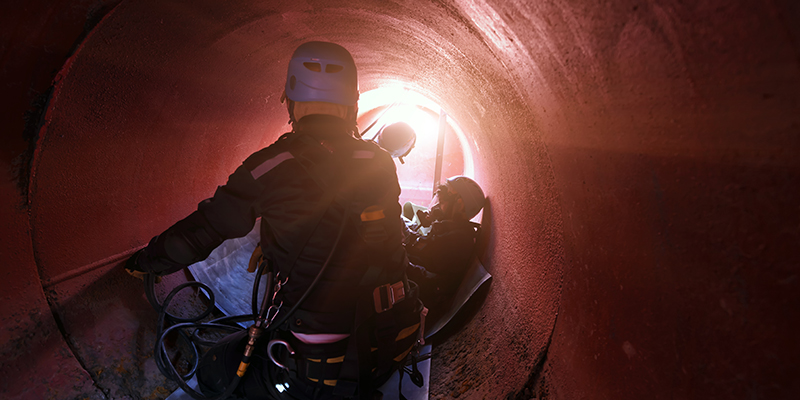
Rushing into a confined space without first assessing the potential dangers involved can have fatal results. Keeping workers and rescuers properly trained on what to do before entering a confined space is required by OSHA for good reason – it saves lives.
Confined spaces by definition are large enough for workers to enter to perform job duties, but have limited entry/exit points and are not designed for anyone to spend long periods of time in.
OSHA defines a permit-required confined space as “a confined space that has one or more of the following characteristics: contains or has the potential to contain a hazardous atmosphere; contains material that has the potential to engulf an entrant; has walls that converge inward or floors that slope downward and taper into a smaller area which could trap or asphyxiate an entrant; or contains any other recognized safety or health hazard, such as unguarded machinery, exposed live wires, or heat stress.”
Workers and rescuers have to be prepared to assess the situation before entering a confined space, so pre-planning is crucial. CLMI Safety Training recommends planning ahead by:
- Identifying anticipated hazards inside the space
- Selecting proper equipment to control the hazards
- Providing good documentation on the necessary controls via the written permit system
- Providing appropriate training for everyone involved in the entry
- Rapidly responding to emergency situations
Preparing the permit to enter a permit-required confined space is a fairly involved process, so another assessment that should be done in pre-planning is whether or not workers actually need to enter the space. It may be possible that long-handled tools or closed circuit television could be used to maintain or inspect a confined space instead of sending a person in.
The most common threat with confined space entry is asphyxiation. The presence of toxic contaminants may not be readily apparent, so oftentimes a worker or would-be rescuer will enter a confined space without realizing the danger they’re in. Using proper air-monitoring equipment is the first step to assessing the safety of a space, then determining what sort of personal protective equipment may be required.
If a worker is injured or unable to exit a confined space and a rescue effort is needed, there are three ways to accomplish this as outlined by OSHA:
- Non-entry rescue
- Entry rescue by company employees
- Entry rescue by emergency responders from outside the company
Each of these rescue efforts also involve pre-planning and assessment of the situation before rushing in, so more victims are not created in the process. Even when calling in paramedics or firefighters, company employees should be able to notify them about the dangers that could be encountered with this particular confined space entry.
To deliver effective confined space entry training and give employees a thorough understanding of the hazards that may be present in their everyday jobs, check out CLMI Safety Training’s video series on working in confined spaces, available in The BizLibrary Collection. This program is a modular training program that covers Confined Space Hazards, Confined Space Protection, Confined Space Ventilation, and Confined Space Entry.
Watch a preview of “Confined Space Entry – A Deadly Situation” from The BizLibrary Collection here:
